HLG 550 V2 Vs 1K HPS Single end.
- Thread starter augusto1
- Start date
hybridway2
Amare Shill
Also, height restrictions keep many on SE / air-cooled. Grow right into the light if it so happens. Hearing about 2.0 umol/j SE-bulbs now though. If that's true, it changes thing in the SE dept.If you have to raise 1000w hps that high above the canopy you must not own fans.. or air conditioning..
OneHitDone
Well-Known Member
HiLUX GRO™ Super HPS Single-Ended Grow LightAlso, height restrictions keep many on SE / air-cooled. Grow right into the light if it so happens. Hearing about 2.0 umol/j SE-bulbs now though. If that's true, it changes thing in the SE dept.

wietefras
Well-Known Member
To prevent bleaching the plants? Good luck with that.If you have to raise 1000w hps that high above the canopy you must not own fans.. or air conditioning..
wietefras
Well-Known Member
Yes, with you it always is. You lack the capacity to really understand basic concepts and on the off chance that you do get it, you simply move the goal posts. Or just dump a shitload of random nonsense and pretend you "proven" something.I see this is going to be a painful argument again.
Which is all now even made much much worse by the fact that you have a financial interest.
Either way, I really should not be needing to "prove"this, but perhaps you understand pictures.
This is how you spread light poorly:
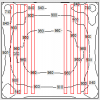
This clearly spreads the light a lot better:
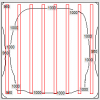
Distribution is determined by the biggest distance between the light sources. So it's much better to have only 15cm between the strips rather than about 40cm between two groups of strips (or boards)
BTW I saw a remark in the thread that light higher up helps with better penetration. That's also wrong.
hybridway2
Amare Shill
That's ridiculous. Only once, one time out if 3 straight years HPS'ng hard-core did one strain get some bleached bud tops.To prevent bleaching the plants? Good luck with that.
Nothing ever happened to me, no matter how close, in the form of bleached leaves like i easily get under led at the same par.
Its an unbalanced spectrum with high 660nm that usually causes bleached bud tips. High intensity of many lights might but HPS is last on the list.
ChiefRunningPhist
Well-Known Member
LolBTW I saw a remark in the thread that light higher up helps with better penetration. That's also wrong.
Tell me, if you raise your light up does your PPFD drop? Hint, yes. This means your tent is not a 100% efficient reflector.
Let's look at 2 of your strips at different hang heights. 1 @ 2" to the canopy ... and 1 @ 24" to the canopy. If you supply both strips with 50W each, the 2" close strip is going to be much more intense at canopy than the 24" hanging strip. You'd have to turn down your 2in strip considerably to counteract this realization. Let's say you had to turn down the 2in close strip by 30W to bring it's total power consumption down to only 20W compared to the 24in hanging strip still being pushed at 50W. Now, at canopy, both strips are equal PPFD even though they are at different wattages and different hang heights. Now let's imagine you raised the 20W strip up a additional 6in or to a total of 8in, increasing the height it was at by 400%. What happens to the canopy PPFD? Now lets raise the 50W strip currently at 24in up by the same 6in, also increasing its height but by only 25%. What happens to its canopy PPFD? The % change is what will determine the "staying power" of the light source. Some of the photons get reflected but not close to all. If they were conserved then you'd not have to keep the strips so low. Moving a strip by 4× its original distance is going to be noticed more at canopy than moving a strip only 1/4 of its original distance. This is just physics. This also means that 6in into sub canopy will have a greater PPFD with a 24in hung light than a 2in hung light when both canopy PPFDs are equal.
Prawn Connery
Well-Known Member
Are you kidding me? Those Dialux images are fake!Yes, with you it always is. You lack the capacity to really understand basic concepts and on the off chance that you do get it, you simply move the goal posts. Or just dump a shitload of random nonsense and pretend you "proven" something.
Which is all now even made much much worse by the fact that you have a financial interest.
Either way, I really should not be needing to "prove"this, but perhaps you understand pictures.
This is how you spread light poorly:
View attachment 4428432
This clearly spreads the light a lot better:
View attachment 4428433
Distribution is determined by the biggest distance between the light sources. So it's much better to have only 15cm between the strips rather than about 40cm between two groups of strips (or boards)
BTW I saw a remark in the thread that light higher up helps with better penetration. That's also wrong.
They are both Photoshopped images of the Dialux simulation I posted here: https://www.rollitup.org/attachments/screen-shot-2019-11-27-at-23-11-07-png.4427732/
Stop being dishonest and post up some real data.
Prawn Connery
Well-Known Member
Show me the bleaching in this photo. Would you like to know how close those two 600W bulbs are? 20-30cm from most of the buds. These plants are an 11-12 week strain, too, so plenty of time to "bleach".To prevent bleaching the plants? Good luck with that.
hybridway2
Amare Shill
72% of the heads around here talk about shit they have NO experience with. With Authority at that.
He makes good points & so do you. Except you are speaking on things you've actually done.
Now if i could reach my plants I'd play par games with you & everyone can see how incredibly Awesome both our layouts cover.
You say you run these boards around 50-80w? That's a huge difference from a QB.
How many diodes, spaced in 1/8's or 16th's please, total dimension of your board?
I have a feeling they are not nearly the intensity/density as the QB's I'm running now.
If they are similiar to the Fo-Top design then indeed they stand for better coverage & easier growing IMO but I've never used one.
So are you going to add some red diodes & make these babies Cream or what?
Oh, been meaning to ask, do you know how i can get in touch with @GRO or?
Last i knew he was doing a run using the same nutes i do & wanted to know how he made out under leds with it. ?
Are you offering one spectrum at the moment?
He makes good points & so do you. Except you are speaking on things you've actually done.
Now if i could reach my plants I'd play par games with you & everyone can see how incredibly Awesome both our layouts cover.
You say you run these boards around 50-80w? That's a huge difference from a QB.
How many diodes, spaced in 1/8's or 16th's please, total dimension of your board?
I have a feeling they are not nearly the intensity/density as the QB's I'm running now.
If they are similiar to the Fo-Top design then indeed they stand for better coverage & easier growing IMO but I've never used one.
So are you going to add some red diodes & make these babies Cream or what?
Oh, been meaning to ask, do you know how i can get in touch with @GRO or?
Last i knew he was doing a run using the same nutes i do & wanted to know how he made out under leds with it. ?
Are you offering one spectrum at the moment?
wietefras
Well-Known Member
I agree. Have you done grows with Gavita DE 1000W at 24" above the plants?72% of the heads around here talk about shit they have NO experience with.
I did and it does cause bleaching. I had a pure white top.
Besides, even at a low 24"for such a light, that's still 20" higher than well spread out leds have to be. In fact I let my plants grow through the frame even if a single one goes to tall here and there. So my point that HPS needs to hang higher than leds is 100% correct.
OneHitDone
Well-Known Member
Your "HPS" is thrown around too loosely and causing the arguments. Gotta continually specify 1000W DE and not assume someone coming in knows what your talking about from a previous post.I agree. Have you done grows with Gavita DE 1000W at 24" above the plants?
I did and it does cause bleaching. I had a pure white top.
Besides, even at a low 24"for such a light, that's still 20" higher than well spread out leds have to be. In fact I let my plants grow through the frame even if a single one goes to tall here and there. So my point that HPS needs to hang higher than leds is 100% correct.
And everyone knows 24" is too close with a 1000W DE HPS
Prawn Connery
Well-Known Member
I personally run them at around 85W per board because I can afford to run more boards for better coverage. But their maximum current rating of 4.5A puts them around 225W, and you can run them at that with a heatsink. Or you can run them up to 150W without a heatsink, as the boards are 415mm x 205mm x 2mm and have 450x 3030 LEDs. They are also CRI95. There are two different spectra: one has near-UV LEDs with 49% total red and the other has no near-UV, but is 52% total red. We get the 620-700+nm boost by using a blend of CRI 90, 95 and 98 LEDs.You say you run these boards around 50-80w? That's a huge difference from a QB.
How many diodes, spaced in 1/8's or 16th's please, total dimension of your board?
I have a feeling they are not nearly the intensity/density as the QB's I'm running now.
If they are similiar to the Fo-Top design then indeed they stand for better coverage & easier growing IMO but I've never used one.
So are you going to add some red diodes & make these babies Cream or what?
There's plenty of info if you're interested here: https://www.rollitup.org/t/high-lights-high-powered-cri95-flowering-boards-made-in-australia.988805/
And here: https://www.rollitup.org/t/high-light-efficiency-tests-teknik-2-47-umol-j-cri-94-2.989161/


Or_Gro left RIU and joined a private forum where he finished his side-by-side grow, but then left the private forum. As far as I'm aware, he's not active online at the moment.hybridway2 said:Oh, been meaning to ask, do you know how i can get in touch with @GRO or?
Last i knew he was doing a run using the same nutes i do & wanted to know how he made out under leds with it. ?
Are you offering one spectrum at the moment?
EDIT: I added PDF files in case the screenshots above are hard to read. We have IES files, too, at different currents/outputs for those who want to play around with Dialux.
Attachments
-
153.4 KB Views: 3
-
155.2 KB Views: 2
Last edited:
hybridway2
Amare Shill
Thank you for the breakdown. Very nice!I personally run them at around 85W per board because I can afford to run more boards for better coverage. But their maximum current rating of 4.5A puts them around 225W, and you can run them at that with a heatsink. Or you can run them up to 150W without a heatsink, as the boards are 415mm x 205mm x 2mm and have 450x 3030 LEDs. They are also CRI95. There are two different spectra: one has near-UV LEDs with 49% total red and the other has no near-UV, but is 52% total red. We get the 620-700+nm boost by using a blend of CRI 90, 95 and 98 LEDs.
There's plenty of info if you're interested here: https://www.rollitup.org/t/high-lights-high-powered-cri95-flowering-boards-made-in-australia.988805/
And here: https://www.rollitup.org/t/high-light-efficiency-tests-teknik-2-47-umol-j-cri-94-2.989161/
View attachment 4428714
View attachment 4428715
Or_Gro left RIU and joined a private forum where he finished his side-by-side grow, but then left the private forum. As far as I'm aware, he's not active online at the moment.
EDIT: I added PDF files in case the screenshots above are hard to read. We have IES files, too, at different currents/outputs for those who want to play around with Dialux.
Yes, definitely summing up the spectrum without having to add.
Now wasnt there white diodes running over say 420 o 400 instead of 450? But then there's the one with more UVA n that has the 380-400 added but its a white not a monochrome nm?
Trying to understand.
I know, ill read.
Prawn Connery
Well-Known Member
Both boards have 300x Nichia NF2W757GT-V3F1 CRI90 2700K that provide most of the power and efficiency.
The red board has 150x Nichia Optisolis 2700K (CRI9 - which provides a 620-660nm boost. So 450 LEDs total.
- which provides a 620-660nm boost. So 450 LEDs total.
The UV board has 90x Nichia Optisolis, and 60x Seoul Semiconductor "Sunlike" 6500K LEDs for the near-UV. So again, 450 LEDs in total.
There are no monos on the boards – they are all white-phosphor, but the Sunlike has a "purple pump" (410-415nm) which is different from most common "blue pump" (450nm) LEDs that do not extend into the near-UV and UVA range.
Likewise, the Optisolis extends much further into the red range than tyipical CRI80 LEDs.
The red board has 150x Nichia Optisolis 2700K (CRI9
The UV board has 90x Nichia Optisolis, and 60x Seoul Semiconductor "Sunlike" 6500K LEDs for the near-UV. So again, 450 LEDs in total.
There are no monos on the boards – they are all white-phosphor, but the Sunlike has a "purple pump" (410-415nm) which is different from most common "blue pump" (450nm) LEDs that do not extend into the near-UV and UVA range.
Likewise, the Optisolis extends much further into the red range than tyipical CRI80 LEDs.
lukio
Well-Known Member
he absolutely smashed his last grow. Do you know your ppms yet?wanted to know how he made out under leds with it. ?
Last edited:
hybridway2
Amare Shill
Always did.he absolutely smashed his last grow with a ridiculous side by side. Do you know your ppms yet?
Gro-gor using TechNaFlora?
lukio
Well-Known Member
do they have a break down? what else ya throwing at em? RO water? DM me? lets fix thisAlways did.
Gro-gor using TechNaFlora?
Prawn Connery
Well-Known Member
So in the interests of fair play (and because @wietefras won't post this himself), here is a Dialux sim for eight 112cm strips. These are Crees (custom strips) at 48W each. Don't mind the PPFD readings – we're more interested in the light spread.Yes, with you it always is. You lack the capacity to really understand basic concepts and on the off chance that you do get it, you simply move the goal posts. Or just dump a shitload of random nonsense and pretend you "proven" something.
Which is all now even made much much worse by the fact that you have a financial interest.
Either way, I really should not be needing to "prove"this, but perhaps you understand pictures.
This is how you spread light poorly:
View attachment 4428432
This clearly spreads the light a lot better:
View attachment 4428433
Distribution is determined by the biggest distance between the light sources. So it's much better to have only 15cm between the strips rather than about 40cm between two groups of strips (or boards)
BTW I saw a remark in the thread that light higher up helps with better penetration. That's also wrong.
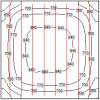
The first thing you notice is the centre weighting of the light spread. The reason for this is the overlapping light in the middle vs the 80% reflected light from the walls (obviously set at 80% reflectivity in Dialux). The middle of the room gets the most overlapping light, the edges get the least.
And just to prove this isn't a set-up, here is another 4x4 with wall-to-wall boards showing the same light distribution (again, never mind the PPFD figures, look at the distribution curves).
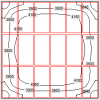
And here we have wall-to-wall strips (or as many as I could fit in Dialux – 28x).
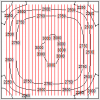
And here we have just a few strips.
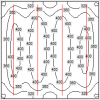
The moral of the story is, no matter how many strips or boards you put in a 4x4, the light footprint will always be weighted towards the centre of the light mass. Thus endeth the debate. And apologies for taking this thread off on a tangent.
Stoned Cold Bulldog
Well-Known Member
well no shit. 460 watts QB vs. 400 hps is supposed to kick the hid in the ass. am i missing something crucial lol.I know things don't always scale in a linear fashion, but I run two QB 288 v2 @ ~230 watts and it consistently out performs the 400 watt hps that I used to run in the same space.
